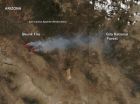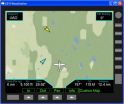(Press-News.org) ANN ARBOR—A device that essentially listens for light waves could help open up the last frontier of the electromagnetic spectrum—the terahertz range.
So-called T-rays, which are light waves too long for human eyes to see, could help airport security guards find chemical and other weapons. They might let doctors image body tissues with less damage to healthy areas. And they could give astronomers new tools to study planets in other solar systems. Those are just a few possible applications.
But because terahertz frequencies fall between the capabilities of the specialized tools presently used to detect light, engineers have yet to efficiently harness them. The U-M researchers demonstrated a unique terahertz detector and imaging system that could bridge this terahertz gap.
"We convert the T-ray light into sound," said Jay Guo, U-M professor of electrical engineering and computer science, mechanical engineering, and macromolecular science and engineering. "Our detector is sensitive, compact and works at room temperature, and we've made it using an unconventional approach."
The sound the detector makes is too high for human ears to hear.
The terahertz gap is a sliver between the microwave and infrared bands of the electromagnetic spectrum—the range of light's wavelengths and frequencies. That spectrum spans from the longest, low-energy radio waves that can carry songs to our receivers to the shortest, high-energy gamma rays that are released when nuclear bombs explode and radioactive atoms decay.
In between are the microwave frequencies that can cook food or transport cell phone signals, the infrared that enables heat vision technologies, the visible wavelengths that light and color our world, and X-rays that give doctors a window under our skin.
The terahertz band is "scientifically rich," according to Guo and colleagues. But today's detectors either are bulky, need to be kept cold to work or can't operate in real time. That limits their usefulness for applications like weapons and chemical detection and medical imaging and diagnosis, Guo says.
Guo and colleagues invented a special transducer that makes the light-to-sound conversion possible. A transducer turns one form of energy into another. In this case it turns terahertz light into ultrasound waves and then transmits them.
The transducer is made of a mixture of a spongy plastic called polydimethylsiloxane, or PDMS, and carbon nanotubes. Here's how it works:
When the terahertz light hits the transducer, the nanotubes absorb it, turning it into heat. They pass that heat on to the PDMS. The heated PDMS expands, creating an outgoing pressure wave. That's the ultrasound wave. It's more than 1,000 times too high for human ears to pick up.
"There are many ways to detect ultrasound," Guo said. "We transformed a difficult problem into a problem that's already been solved."
Though ultrasound detectors exist—including those used in medical imaging—the researchers made their own sensitive one in the form of a microscopic plastic ring known as a microring resonator. The structure measures only a few millimeters in size.
They connected their system to a computer and demonstrated that they could use it to scan and produce an image of aluminum cross.
The response speed of the new detector is a fraction of a millionth of a second, which Guo says can enable real-time terahertz imaging in many areas.
The system is different from other heat-based terahertz detection systems because it responds to the energy of individual terahertz light pulses, rather than a continuous stream of T-rays. Because of this, it isn't sensitive to variations in the outside temperature, Guo says.
INFORMATION:
The study, "Efficient real-time detection of terahertz pulse radiation based on photoacoustic conversion by carbon nanotube nanocomposite," is published online in Nature Photonics. The research is funded by the National Science Foundation and the Air Force Office of Scientific Research.
Jay Guo: http://www.guogroup.org
New 'T-ray' tech converts light to sound for weapons detection, medical imaging
2014-05-19
ELSE PRESS RELEASES FROM THIS DATE:
Study shows dementia patients benefit from holistic exercise program
2014-05-19
Philadelphia, PA, May 19, 2014 – While dementia patients can often suffer from depression and declining physical and mental ability, exercise has been shown to help improve both their physical and psychological wellbeing. Researchers at Teesside University in the U.K. investigated how combining cognitive activities and elements of yoga, tai chi, qigong and meditation with routine physical exercise affected dementia patients. They found that a holistic exercise program focusing on both mind and body can help improve quality of life for dementia patients. Their findings are ...
Optical brain scanner goes where other brain scanners can't
2014-05-19
Scientists have advanced a brain-scanning technology that tracks what the brain is doing by shining dozens of tiny LED lights on the head. This new generation of neuroimaging compares favorably to other approaches but avoids the radiation exposure and bulky magnets the others require, according to new research at Washington University School of Medicine in St. Louis.
The new optical approach to brain scanning is ideally suited for children and for patients with electronic implants, such as pacemakers, cochlear implants and deep brain stimulators (used to treat Parkinson's ...
Skunk Fire, Arizona
2014-05-19
The Skunk Fire continues to burn on the San Carlos Apache Reservation in southeastern Arizona and NASA's Aqua satellite captured an image of the smoke on May 17 at 20:15 UTC (4:15 p.m. EDT/1:15 p.m. MST). A Fire Weather Watch has been posted for the region for May 20.
The Moderate Resolution Imaging Spectroradiometer or MODIS instrument that flies aboard NASA's Aqua satellite captured this photograph of the smoke. The extent of the fire (the heat) is outlined in red in this image).
According to Inciweb, the multi-U.S. agency Incident Information System website that ...
Gastroenterology highlights new microbiome research
2014-05-19
Bethesda, MD (May 19, 2014) — The editors of Gastroenterology, the official journal of the American Gastroenterological Association (AGA) Institute, are pleased to announce the publication of this year's highly anticipated special 13th issue on the intestinal microbiome, which is considered one of the hottest areas of science today.
"We are beginning to understand the ways by which the microbial environment of the gut may play a role in both the maintance of human health and the development of certain diseases. Data in this special issue of Gastroenterology may lead ...
Liberating devices from their power cords
2014-05-19
Imagine a future in which our electrical gadgets are no longer limited by plugs and external power sources.
This intriguing prospect is one of the reasons for the current interest in building the capacity to store electrical energy directly into a wide range of products, such as a laptop whose casing serves as its battery, or an electric car powered by energy stored in its chassis, or a home where the dry wall and siding store the electricity that runs the lights and appliances.
It also makes the small, dull grey wafers that graduate student Andrew Westover and Assistant ...
Having and raising offspring is costly phase of life for baboon moms
2014-05-19
Observations made over the past 29 years in Kenya as part of one of the world's longest-running studies of a wild primate show how having offspring influences the health of female baboons. These observations highlight that females are mostly injured on days when they are likely to conceive. In addition, injuries heal the slowest when they are suckling their young. The study, published in Springer's journal Behavioral Ecology and Sociobiology, is led by Elizabeth Archie of the University of Notre Dame in the US and the National Museums of Kenya.
Reproduction can be dangerous ...
UT Dallas lab eliminates rare metals in electric motors
2014-05-19
A team from the Renewable Energy and Vehicular Technology Laboratory(REVT) at UT Dallas was one of a few research groups selected for advanced participation in a Department of Energy conference aimed at presenting the next generation of energy technologies.
The DOE's Advanced Research Projects Agency-Energy (ARPA-E) program hosts an annual summit in Washington, D.C., for researchers, entrepreneurs, investors, corporate executives and government officials to share transformational research funded through the program.
Dr. Babak Fahimi, professor of electrical engineering ...
Genes play key role in brain injury risk for premature babies
2014-05-19
Premature babies' risk of brain injury is influenced by their genes, a new study suggests.
Researchers have identified a link between injury to the developing brain and common variation in genes associated with schizophrenia and the metabolism of fat.
The study builds on previous research, which has shown that being born prematurely – before 37 weeks – is a leading cause of learning and behavioural difficulties in childhood.
Around half of infants weighing less than 1500g at birth go on to experience difficulties in learning and attention at school age.
Scientists ...
Engineers find way to lower risk of midair collisions for small aircraft
2014-05-19
Researchers at North Carolina State University have developed new modifications for technology that helps pilots of small aircraft avoid midair collisions. The modified tools significantly improved pilot response times in making decisions to avert crashes.
At issue are "cockpit displays of traffic information" (CDTIs). These are GPS displays used by private pilots to track other aircraft in their vicinity. However, pilots often focus on the closest aircraft on the display – a habit that can pose a significant hazard.
If the pilot of Plane A sees two planes on the CDTI, ...
How octopuses don't tie themselves in knots revealed by Hebrew University scientists
2014-05-19
An octopus's arms are covered in hundreds of suckers that will stick to just about anything, with one important exception: those suckers generally won't grab onto the octopus itself, otherwise the impressively flexible animals would quickly find themselves all tangled up.
Now, researchers from the Hebrew University of Jerusalem report that they discovered how octopuses manage this feat, even as the creatures' brains are unaware of what their arms are doing. A chemical produced by octopus skin temporarily prevents their suckers from sucking.
"We were surprised that ...




